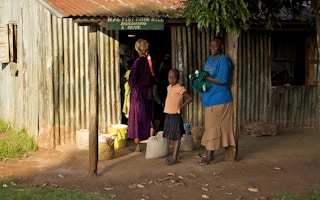For Inonge Imutowana, buying food for her family of six is becoming increasingly costly. On the outskirts of the capital, a 25-kilo bag of staple mealie meal that cost 65 kwacha a year ago now is selling for 140 kwacha ($14).
Across Zambia, drought that swept across the region last year, leading to widespread crop failure, has sent cereal prices soaring.
The high cost of buying food has persuaded a share of small-scale farmers to hang onto their maize, rice and cassava harvests and mill them for their own household use and for their livestock, rather than selling the grain into the market.
But a combination of higher fuel prices and unstable electrical supplies - both the result of lack of rainfall hitting hydropower - mean many small grain mills are charging higher prices for milling, or don’t have sufficient capacity.
But Zambia’s government hopes it has an answer: Since 2015 it has been installing hundreds of small solar-powered mills in rural areas as a way to help hold down the price of producing food.
“
Before this, we used to take (our grain) to a diesel-operated hammer mill (about 20 kilometres away) or buy commercially produced mealie meal in smaller quantities, just as we could afford it.
Inonge Imutowana, farmer, Zambia
Cheaper, closer
One of those, built last November, is now operating just seven kilometers from Imotowana’s farm, which lies about 50 kilometres east of Lusaka.
“Before this, we used to take (our grain) to a diesel-operated hammer mill (about 20 kilometres away) or buy commercially produced mealie meal in smaller quantities, just as we could afford it,” said the 54 year-old farmer.
Now “it is cheaper milling here,” she said.
According to the Zambia Cooperation Federation (ZCF), a government agency that is installing the mills, over 250 have has been set up so far out of 2,000 planned.
Patrick Mumbi, an operator of one of the plants, said the 60 solar panels that power the mill can generate 15 megawatts of electricity.
“To mill maize or rice, we need less than nine megawatts of electricity” each day to process about two tonnes of grain, he told the Thomson Reuters Foundation. That means “we have surplus electricity output”.
Unfortunately, the plant does not have any means of capturing that power in batteries, to charge cellphones or provide lighting at night, he said.
The Chinese-manufactured solar mills cost about $70,000 each including installation, according to ZCF.
Lower prices?
Whether the mills will help hold the line on cereal price hikes remains to be seen, however, some analysts say.
Clement Mwiinga, a lecturer at the University of Zambia, said the problem is that many farmers are under contract to sell their grain to the government.
That grain is then sold at subsidised prices to commercial milling firms that are supposed to supply the national market with food at moderate prices.
But government officials have accused some commercial millers of holding onto government grain and selling it illegally to drought-hit neighbouring countries at higher prices.
Mwiinga said it is difficult to monitor whether commercial millers are selling government grain to food insecure countries such as Malawi, the Democratic Republic of Congo and Mozambique, largely because non-government grain can legally be sold in that way.
The Indaba Agricultural Policy Research Institute (IAPRI) also says government efforts to stabilise food prices by routing subsidised grain through commercial millers have not lowered prices for mealie meal and other staples.
To improve the situation, “we need to have a clear standard operating strategy on how to deal with shortfalls and bumper crop harvests,” Chance Kabaghe, IAPRI director, said in December, at the launch of a maize outlook report.
The country is expected to receive normal to above normal rainfall this rainy season, as it begins to recover from last year’s drought, according to the Zambia Meteorological Department.
The Southern Africa Regional Climate Outlook also predicted that most parts of southern Africa should receive good rainfall between January and March.
This story was published with permission from Thomson Reuters Foundation, the charitable arm of Thomson Reuters, that covers humanitarian news, climate change, resilience, women’s rights, trafficking and property rights. Visit http://news.trust.org/climate.










